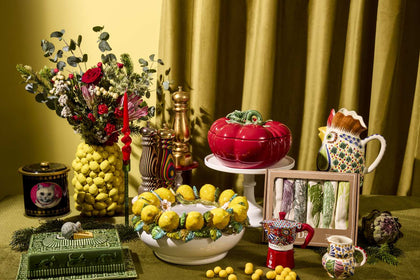
Haggis Recipe – For Burns Night
by Nicola Lando
-
60 minutes prep time
-
240 minutes cook time
-
Difficult

How do you make haggis?
It’s Burns Night – and you’re wearing a touch of tartan. You press ‘play’, and the sound of bagpipes cuts through the dinner party chatter.
As the haggis is piped to the table, and addressed with Robert Burns’ Ode to A Haggis, you’re bursting with pride, because this isn’t any old haggis – nay, this is the haggis of all haggises.
Making your own haggis is not for the faint-hearted.
But if you've got the stomach to cook it from scratch, then you’ll be rewarded with the most delicious flavours and textures which far surpass any shop-bought variety.
Plus if you’re a meat eater, it’s good to know how to cook with the whole animal.
What is in a traditional haggis?
Haggis is a recipe for offal, also called ‘pluck’. Stomach casing is stuffed with a highly flavoured mix of oatmeal, suet, and offal.
There are three unusual ingredients in a haggis.
- Firstly, the ox bung, which is the last metre of an ox’s intestine and like a very large sausage casing, is for stuffing the haggis into. Although you can use a pudding basin intead - see further down the article!
- Secondly, coarse oatmeal or pinhead oats. These look very different to traditional porridge oats, and provide texture without going mushy.
- Finally, there’s the ‘pluck’, or the heart, lungs, and liver of a lamb, often with a piece of windpipe intact, which gives the haggis its intense rich meaty flavour.
The main spice in haggis is black pepper. We’ve used Sarawak black pepper – if you can, grind the pepper fresh so it is most intense.
Other than pepper, season the haggis as you wish! We’ve used coriander, and mace. Before stuffing the haggis, fry a little of the mixture, taste, and then decide.
You might need to call around a few butchers before finding one who will sell pluck.
If a whole pluck isn’t available, the constituent parts should be easier to get hold of.
A typical 1.4kg lamb pluck is roughly 550g liver, 550g lungs, and 250g of heart (plus a few other bits trimmed off). The lungs and heart could be substituted for 50:50 liver and stewing meat.
Pluck can also vary wildly in weight – we’ve had them from just over a kilo up to 2.5kg.
Weigh your pluck, and scale the recipe accordingly. Follow the full recipe below to make your own haggis.
How can you make a haggis without an ox bung?
In the recipe below we use the very traditional ox bung, however instead you can also steam a haggis in a pudding basin.
Pack the filling very tightly into a pudding basin, and then tie on a lid of baking parchment and foil - as you would to steam a traditional English pudding or Christmas pudding.
Steam until piping hot - it’s very easy to check using a probe thermometer.
When you are ready to serve, you can then turn out your ‘haggis pudding’ onto a plate, and pour over a few tablespoons of whisky and light it - for a flamed centrepiece just like a Christmas pud!
What is the history of haggis?
The national dish of Scotland, the history of haggis is somewhat mysterious.
Some say that the Romans introduced a similar dish to the UK, and others suggest it is a Viking recipe.
However, sausage-like recipes have been eaten for centuries so it’s difficult to pin down exactly where this king of sausages hails from.
What do you eat with haggis?
Haggis is traditionally served with neeps and tatties; mashed swede and potatoes.
Some people also like to serve haggis with a little dram of whisky – the earthy, warmth of the spirit is delicious with those rich meaty flavours.
Can you fry haggis?
When you make haggis from scratch you should boil or steam it to cook the haggis thoroughly. This is also usually true of any shop-bought haggis.
However, once the meat has been cooked thoroughly you can then fry slices for even more flavour.
Frying haggis will caramelise the meat and give it extra sweetness. It can be great on toast for breakfast!
Do you eat the skin on haggis?
No! Haggis skin is usually extremely tough - much tougher than a sausage casing. We’d suggest leaving it at the side of the plate.
How can you make a vegetarian haggis?
Make a vegetarian haggis by swapping in your preferred combination of lentils, mushrooms, and rolled oats to create a similar texture and flavour.
Include finely chopped onions and spices like black pepper and cayenne pepper to keep the authentic taste. You can cook vegetarian haggis in a conventional oven or steam it, just like the traditional one.
Serve it with neeps and tatties and a rich whisky sauce for a complete meal that everyone can enjoy.
Ingredients Serves: 20
- 1 ox bung, soaked for 4 hours (or overnight) and well rinsed
- 1 lamb’s pluck (heart, lungs & liver), approx 1.4kg
- 500g beef or lamb trimmings, or stewing meat (you can make a haggis without the trimmings, but replace with 200g-300g suet)
- 200g suet
- 500g coarse oatmeal (the same as pinhead oats)
Seasoning
- 2 tbsp freshly ground Sarawak pepper
- 1 tsp freshly ground mace
- 4 tsp freshly ground coriander
- 4 tsp fine sea salt
Advance preparation – cooking the meat
- Rinse whole pluck in cold water. Trim off any large pieces of fat. If the windpipe is still intact, cut it away and put straight in the bin.
-
Place the pluck into a good sized stock pot, and cover with cold water.
The lungs float, so you will need to fill the pot such that using a lid keeps the pluck mostly submerged; or cover with a plate, and something heavy. - Bring to the boil, skimming the surface regularly. Gently simmer for 2 hours.
- Lift all the meat from the pot with tongs or a slotted spoon, and rinse each piece in cold water to remove any scum. Place in a bowl and leave to cool.
- Strain the cooking liquid through a fine sieve, and put back on the stove to reduce. Reduce until you are left with just under a litre of liquid. Leave to cool.
Mixing the haggis
-
Finely dice the cooked heart and lungs.
Grate the liver using the coarse side of the grater. Finely dice the trimmings. -
Rinse the ox bung thoroughly in plenty of cold water.
Turn it inside out and rinse again. Spoon the mixture into the haggis. Make sure there is space for expansion – they are liable to split as the oats absorb the liquid and meat juices during cooking and expand, plus the casing contracts as it is cooked. -
When the haggis is the size required, expel any extra air (again making sure there is a little extra casing), pinch, tie with string, and cut away from the rest of the bung.
Tie the new end of the bung with string, and continue stuffing. Once the haggis are all neatly tied, any spare can be frozen and kept for another day. -
Pierce a few times with a needle (or tip of kitchen thermometer, etc), and place in a pan of cold water, and slowly bring to the boil.
Simmer for 1.5-2 hours depending on the thickness of the haggis. When you are ready to eat, insert a thermometer into the centre, and check it reads at least 74°C. - Pipe to the table with bagpipes. Address it with a rendition of Ode To A Haggis, and then dramatically stab and rip open the haggis with a sgian dubh.
If the haggis skin does split. you can very quickly remove from the whole haggis from the pan, and wrap tightly in foil. Simmer the carefully wrapped parcel in an inch or two of water to continue cooking.
Browse more lamb recipes here

The happiness of a 3kg home-made haggis

About the author
Nicola is co-founder and CEO at Sous Chef. She has worked in food for over ten years.
Nicola first explored cooking as a career when training at Leiths, before spending the next decade in Finance. However... after a stage as a chef at a London Michelin-starred restaurant, Nicola saw the incredible ingredients available only to chefs. And wanted access to them herself. So Sous Chef was born.
Today, Nicola is ingredients buyer and a recipe writer at Sous Chef. She frequently travels internationally to food fairs, and to meet producers. Her cookbook library is vast, and her knowledge of the storecupboard is unrivalled. She tastes thousands of ingredients every year, to select only the best to stock at Sous Chef.
Nicola shares her knowledge of ingredients and writes recipes to showcase those products. Learning from Sous Chef's suppliers and her travels, Nicola writes many of the recipes on the Sous Chef website. Nicola's recipes are big on flavour, where the ingredients truly shine (although that's from someone who cooks for hours each day - so they're rarely tray-bakes!).


